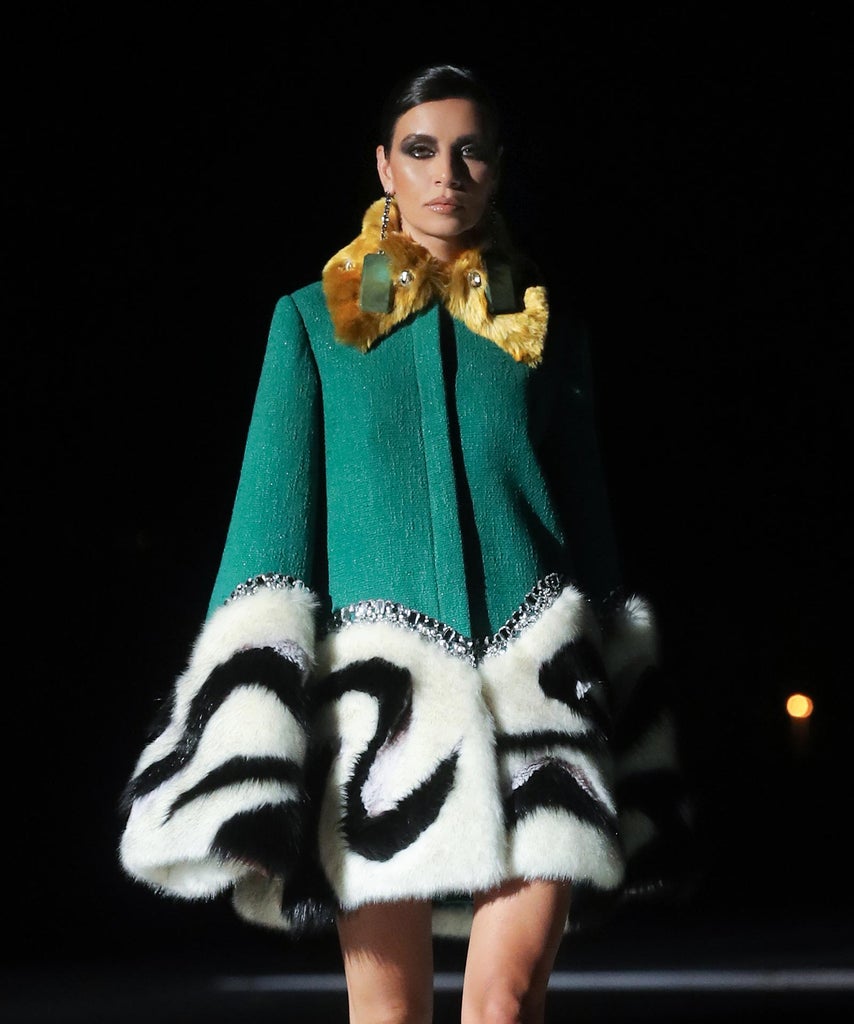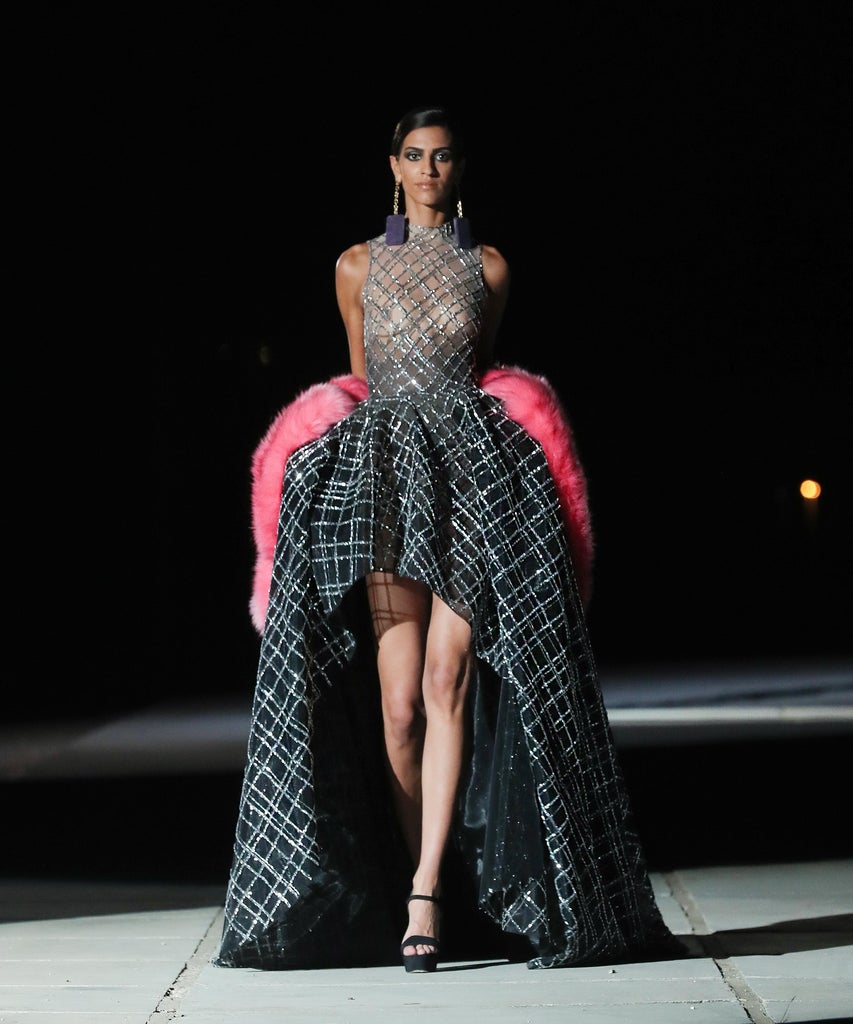For Lebanese Fashion Designers, Couture Must Go On

Following the COVID-19 outbreak, fashion has been hit hard. From factories forcing to close due to stay-at-home orders and brands shutting their doors for good to fashion weeks being canceled, the pandemic has left the industry struggling. The impact is still apparent months later during an event like Haute Couture Week, shows for which are always held in Paris but, this year, turned digital — a first-ever for luxury fashion. Lebanese designers are a mainstay during this fashion week, and some are going ahead virtually this season. “Only time will tell what will happen afterwards, and I hope for the best,” says Lebanese designer Georges Hobeika.
While Lebanon was already struggling economically at the start of 2020, they were thriving fashion-wise. Red carpets for the awards season were crawling with designs from Lebanese designers. For the 92nd Academy Awards red carpet, Killing Eve’s Sandra Oh wore an ecru, embroidered evening gown featuring white silk threads, silver sequins, and flowers made of organza from the Elie Saab SS2020 Haute Couture collection. Chrissy Teigen shined in a turquoise Georges Hobeika gown from his SS20 Haute Couture collection at the Vanity Fair Oscar Party; for the same event, Little Fires Everywhere actress Kerry Washington wore a two-piece ensemble inlaid with multicolored jewels from Zuhair Murad’s SS20 Couture collection.
In fact, the tiny Levantine nation in the Middle East has had an outsize impact on the red carpet, and on couture fashion, for years. Designers like Georges Chakra, Zuhair Murad, Georges Hobeika, Elie Saab, Azzi and Osta, Krikor Jabotian, Nicolas Jebran, and Steven Khalil are beloved by both celebrities and other non-famous shoppers across the world, who adore glamorous custom creations.
At this moment, however, the country these designers hail from is anything but glamorous. Last year ended with a revolution in full force, which has picked up again, as the world is trying to get past Covid-19. The economy is in a bad situation with a fast devaluing currency. Still, even with a pandemic still looming and its global economic aftershocks, coupled with Lebanon’s continuous economic problems, Lebanese designers are managing to move forward with their businesses. “The Lebanese people have always been optimistic, no matter the situation or dire circumstance, and we thrive on challenges,” says Hobeika.
While during this week’s official Haute Couture AW20-21 event, George Hobeika, Maison Rabih Kayrouz, and Elie Saab are the only Lebanese designers showing, others like Georges Chakra and Azzi and Osta will premiere their new collections later this month. “We are now back at work with the hope and resilience that characterizes us as Lebanese people,” says Chakra. “We have completed a couture capsule collection for the fall-winter 2021 season, which we will be launching in July online.” Other designers like Tony Ward, whose gowns in the U.S. are sold in famed New York bridal boutique Kleinfeld, is moving away from the traditional fashion weeks altogether.

The Lebanese designers’ impact on haute couture goes back a long way. The various powers that have controlled Lebanon — the Greeks, Romans, Ottomans, and French — have all influenced the country’s artisanry, starting in the villages where women learned to sew, which has given rise to the art of couture that the country is known for.
As a result of this, Lebanese designers have become known for the intricate beadwork and embroidery (that can often take hundreds of hours to complete!) that makes a Couture collection. While Italian and French fashion houses are gifted in couture as well, countries like Lebanon, Philippines, and India take the craft to a new level, with beading, lace, and handmade embroidery that’s not only exquisite but also part of their history.
To date, like many in the fashion industry worldwide, Lebanese people have been laid off, businesses have closed their doors or greatly reduced operations, people have received half their salaries — or no salary at all. A recently formed government, led by Prime Minister Hassan Diab, was formed on January 22, but many are skeptical of the current executive leadership’s ability to lift the country out of its economic slump.
The country wasn’t always like this. After Lebanon gained independence from France, it was known as the Paris of the Middle East, and both Europeans and other Arabs flocked there for holidays. The capital, Beirut, in the 1950s, ‘60s, and ‘70s, with its Monte Carloesque sea-lined shopping streets, looked like a different city — and Lebanon as a whole was the beacon of fashion and culture in the Middle East. This Mediterranean-kissed coastal nation was the It place to come to and enjoy life, buy the latest designs, and party. Fashion for the region was headquartered in Lebanon, not in Dubai, where it is today. But, for the past 40 years, Lebanon’s attraction has been declining for tourists. The end of its 15-year civil war marked the beginning of rampant corruption inside the country, and that, coupled with complicated sectarianism, has stifled the Lebanon that was.
Hobeika, who dresses celebrities like Jennifer Lopez, Bella Thorne, and Kat Graham, says the industry will survive because of designers’ skill and dedication. “We’re known for creating more complex and intricate pieces,” he says. “Our commitment to the time and effort it takes to learn the delicate and artisanal craft of couture embroidery has been vital to distinguishing Lebanese haute couture creations.”
Ward, who is known for his embroidery, craftsmanship, and sustainable efforts in couture, is aware of the challenges but is hopeful that, through craft like his, couture in Lebanon will survive. During the lockdown, he shifted from an atelier of couture to producing bed sheets and medical protective suits for hospitals. “We live in an unstable country, and this has been the case for as long as I can remember,” he says. “But this time it’s a different kind of challenge, and I constantly aim to be creative at finding solutions.”
Equally optimistic is Chakra, who has dressed Kate Beckinsale and Nina Kiri, and whose gowns have appeared in The Devil Wears Prada. “It is very difficult as a designer and artist not to be affected by what is going on around you,” he says. “The terrible chaos and hurt that we as Lebanese people are going through has struck us all to the deepest parts of our core. But the Lebanese people are strong, and hope for a better future. This is what we aspire for and what is helping the team and the entire atelier push through.” But, speaking candidly on the state of affairs in Lebanon, he states, “We are doing the best we can. But for any business that is working in Lebanon and contributing to the economy, this [economic situation] is something that is unacceptable.”
Ward, who learned couture making from his father and received a formal education in Paris, relies on international clientele to keep his business going. “We’re lucky enough to be working with international markets, and being able to financially start from scratch while opening accounts abroad,” he says. According to him, Tony Ward’s Paris runway shows, as well as trunk shows in Palm Beach, New York, Mexico, and other countries in the Middle East, contribute to the brand’s survival and success. For now, his aim is for the Maison “to keep moving at [our] own pace and drift from the official calendars.”
Up-and-coming designers are also still trying to grow their businesses. Myrna Bocti and Rania Karam, the co-founders of MyRan, went from selling online and at pop-ups to opening a flagship store in November during the revolution in Beirut. “We’re still positive and hoping for the country to become better,” says Bocti.
As George Chakra watched celebrities like actress Lilly Singh and model Molly Simms wear his artistic creations on the red carpet during the awards season this year from Beirut, he saw a sign that the country’s fortunes — and those of its fashion designers — were on the rise. “My gowns for this awards season were definitely statement pieces,” he said, “and a reminder that Lebanese artists and designers have made it to the far reaches of the world and that they will prevail.”
Like what you see? How about some more R29 goodness, right here?
The Digital Fashion Experience Isn’t The Same
Your Fashion Guide To The Oscars Red Carpet
Sies Marjan Shuts Down Amidst COVID-19
Thanks for reading.
Please Share, Comment, Like the post And Follow, Subscribe CTS Store.
fromSource




Post a Comment